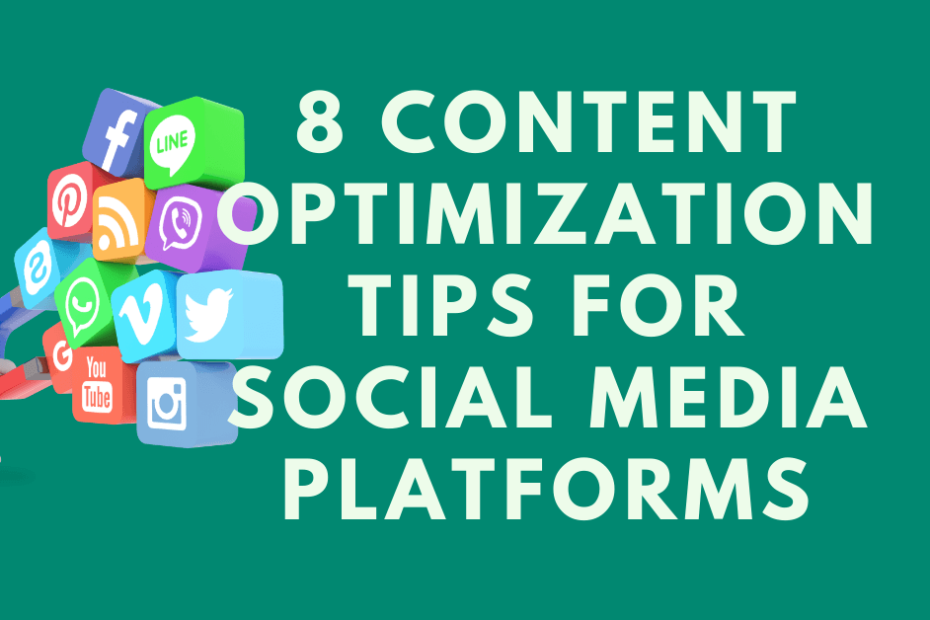It’s no secret that social media platforms like Facebook, Twitter, and Instagram can be extremely valuable tools for businesses. But just because they’re popular doesn’t mean they’re easy to use. In fact, if you’re not careful, your social media content can end up being ineffective and irrelevant. That’s why it’s especially important to optimize your content for social media platforms in order to achieve the most impact. Here are 8 tips for optimizing your social media content for success.

1) Content is still king
Social media posts are an important part of digital marketing. We live in content is king world, and social media has become an increasingly popular way to share content that works well with these platforms. It’s important to keep your posts optimized, through different content types. If you want more visibility on social media platforms, there are some things you can do to make sure you have a good social presence. Here are eight content optimization tips for social media.
2) Structured content is easier to optimize
From a content-optimization standpoint, it’s easier to publish web pages that follow a structured format. You can use social media platforms like Facebook, Twitter, and LinkedIn for repurposing or linking back to your websites by creating posts that adhere to their guidelines.
3) Use your keywords correctly
Social media optimization, or social media marketing, is a critical aspect of your digital marketing strategy. In some ways, it can be more important than on-site SEO and optimizing your web pages. You want to make sure you’re writing posts that are optimized for all major social media platforms—and that you’re using different styles for each platform. Here are some quick tips for writing optimally for each platform.
4) Add visual elements whenever possible
In a world where more and more people are using social media, it’s important to stand out from other brands. One easy way to do that is by adding visuals to your posts whenever possible. This can include pictures, infographics, animated GIFs—anything that stands out from what else is on your audience’s feed. Sometimes I get lazy about including visuals and realize my content just looks like a boring block of text compared to everyone else’s posts. Visual elements are a must!
5) Don’t go overboard with hashtags and mentions
Though it’s tempting to add lots of hashtags and @mentions to your posts, these tactics tend to work against you. Include one or two strategic hashtags or mentions in a post that is designed to be shared on social media platforms, like Facebook, Instagram, Twitter, and LinkedIn. Then, monitor for engagement over time; if no one else is engaging with your posts (no comments, likes, or shares), then consider reducing your use of these strategies until they start working for you.
6) Showcase expert status with visual assets
Images, infographics, and videos are key to getting your message across on social media. Not only do these assets make it easier for followers to quickly digest your message, but visuals also make it easier for you to showcase your expertise as a leader in your industry.
7) Keep your eye on the analytics
Today’s digital marketing landscape is all about metrics. Some social networks, like Twitter and Facebook, offer analytics to users. Google Analytics is great for analyzing traffic, and new tools are being created every day to help you analyze social media engagement. Measuring which content does best will help you optimize your posts in an effective way for all of your social media channels! In case it’s not obvious: Monitor your brand mentions as well!
8) Stay consistent across all platforms
Consistency and uniformity are essential for brands on social media. If you’re tweeting every two hours about your new product, but you’re posting to Facebook once a day about an entirely different subject, it will turn off your followers. Each platform is tailored to its users, so keep your content optimized and relevant across all platforms.
Conclusion
Whatever your writing goals, being strategic about how you use content optimization will help ensure that your writing stays relevant and interesting to both current and future readers. When it comes to creating unique content with high engagement potential, it can be tempting to push boundaries and go off-script. It’s important to remember that rule of thumb: take care of your users first. Content optimization can keep you focused on what really matters—the reader. Social Media Marketing course will teach you how to use YouTube, TikTok and Twitter to increase sales.
For more Instagram updates, you can also check.


Pingback: What You Need to Know About International SEO - DZ Says
Pingback: Top Six LinkedIn Sales Navigator Features - DZ Says